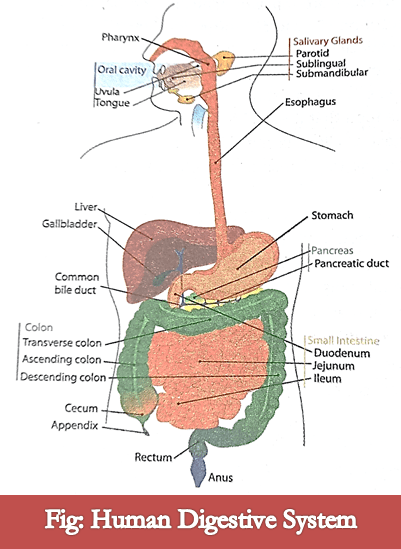Human Digestive System:
The Human Digestive System consists primarily of the digestive tract or the series of structures and organs through which food and liquids pass during their processing into forms absorbable into the bloodstream.
A digestive system is a group of organs working together to convert food into energy and basic nutrients to feed the entire body. Food passes through a long tube inside the body known as the alimentary canal or gastrointestinal tract (GI tract). The alimentary canal is made up of the oral cavity, pharynx, esophagus, stomach, small intestines, and large intestines.

Human Digestive System Parts:
1. Mouth: Food begins its journey through the digestive system in the mouth. It is also known as the buccal cavity or oral cavity. Inside the mouth are many accessory organs that aid in the digestion of food – the tongue, teeth, and salivary glands. Teeth chop food into small pieces, which are moistened by saliva before the tongue and other muscles push the food into the pharynx. Mechanical digestion of food by chewing occurs in the buccal cavity.
2. Pharynx: The pharynx or throat is a funnel-shaped tube connected to the posterior end of the mouth. It is responsible for the passing of masses of chewed food from the mouth to the esophagus. The pharynx also plays an important role in the respiratory system. Because it serves two different functions, it contains a flap of tissue known as the epiglottis that acts as a switch to route food to the esophagus and air to the larynx.
3. Esophagus: The esophagus is a muscular tube connecting the pharynx to the stomach. It carries swallowed masses of chewed food along its length. At the inferior end of the esophagus is a muscular ring called the lower esophageal sphincter or cardiac sphincter. The function of this sphincter is to close the end of the esophagus and trap food in the stomach.
4. Stomach: The stomach is a muscular sac that is located on the left side of the abdominal cavity, just inferior to the diaphragm. In an average person, the stomach is about the size of the two fists placed next to each other. This major organ acts as a storage tank for food so that the body has time to digest large meals properly. The stomach also contains hydrochloric acid and digestive enzymes that continue the digestion of food that began in the mouth.
5. Small Intestine: The small intestine is a long, thin tube about 1 inch in diameter and about 10 feet long. It is located just inferior to the stomach and takes up most of the space in the abdominal cavity. The entire small intestine is coiled like a hose and the inside surface is full of many ridges and folds. These folds are used to maximize the digestion of food and absorption of nutrients. By the time food leaves the small intestine, around 90% of all nutrients have been extracted from the food that entered it.
6. Large Intestine: The large intestine is a long, thick tube about 21/2 inches in diameter and about 5 feet long. It is located just inferior to the stomach and wraps around the superior and lateral border of the small intestine. The large intestine absorbs water and contains many symbiotic bacteria that aid in the breaking down of wastes to extract some small amounts of nutrients.
7. Rectum and Anus: Faeces in the large intestine exit the body through the anal canal and anus after being temporarily stored in the rectum.